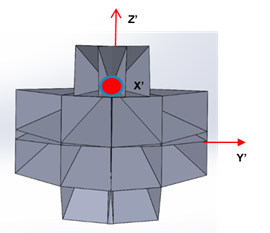Overview
The driving science of X-ray all-sky monitoring calls for new generation instruments with high sensitivity, good angular resolution (a few arc-minutes or less) and a large sky coverage (field of view of order of thousands square degrees). These requirements can be fulfilled by wide-field X-ray focusing optics—the emerging lobster-eye Micro-Pore Optics (MPO), whose focusing imaging results in enormously enhanced gain in signal to noise, and hence high detecting sensitivity. EP carries a Wide-field X-ray Telescope (WXT) with a large instantaneous FoV, which adopts such a novel lobster-eye MPO technology. Complementary to this wide-field instrument is a Follow-up X-ray Telescope (FXT) with a large effective area and a narrow field-of-view. Figure 1 shows a possible configuration of the EP payload.

Figure 1 Configuration of the EP payloads alignment, with twelve WXT modules surrounding two FXT telescopes.
WXT consists of 12 identical modules with 375 mm focal length, each covering about 300 square degrees. The 12 modules make a total un-vignetted FoV of WXT of about 3600 square degrees (~1.1 steradian). An illustration of the WXT and FXT FoV configuration is shown in Figure 2. WXT has a large-format focal plane of approximately 420mm by 420 mm. The baseline choice of the focal plane detectors is CMOS imaging sensors, developed by Gpixel Inc. in China.

Figure 2 Illustration of the field-of-views of the WXT modules and the FXT.